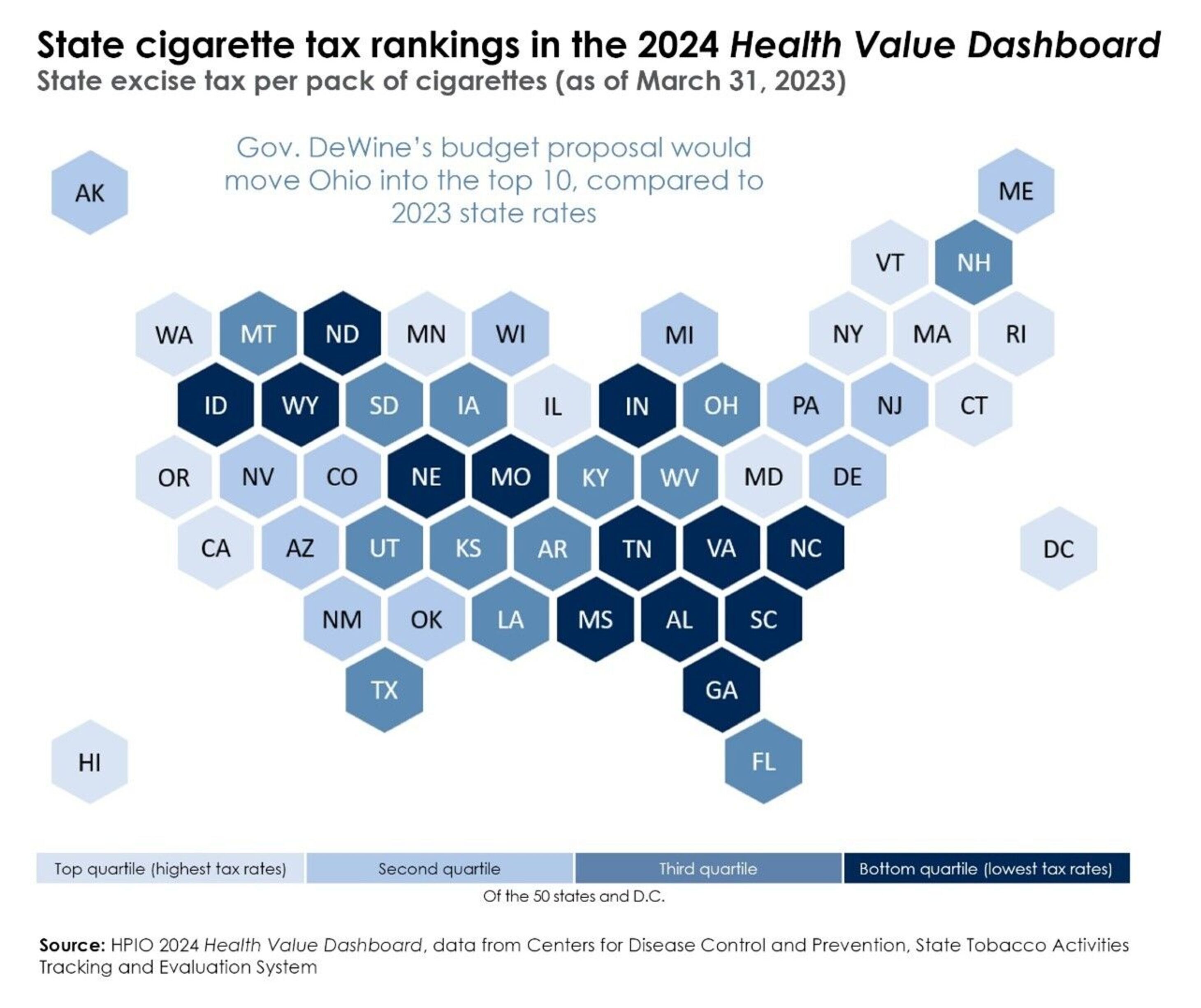November 2024

November 2024
The Ohio Health Value Review is a quarterly electronic update from the Health Policy Institute of Ohio designed to provide evidence-informed resources and highlight opportunities for sectors to work together to improve health value in our state. If you have questions about the newsletter or have suggested tools or resources you would like to see included in future editions, please contact Nick Wiselogel, HPIO’s Vice President of Communications and Design.
Health value graphic
In April, HPIO released the sixth edition of its Health Value Dashboard. The 2024 Dashboard found that Ohio ranks 44th in the nation in health value, a combination of population health and healthcare spending. That means that Ohioans are less healthy and spend more on health care than people in most other states. Ohio ranks in the bottom quartile for population health and third quartile for healthcare spending.
The Dashboard spotlights several policy priorities to improve health value, including addressing mental well-being in Ohio. As illustrated below, data shows that mental health challenges are common in Ohio, with a quarter of adults reporting depression in 2022.
The Dashboard highlights the following policies that could drive improvement in Ohio:
- Improve access to telemental health services and reduce existing barriers for patients, such as gaps in insurance coverage and lack of broadband availability.
- Fund programs with evidence of mental health benefits, such as mental health first aid, cross-age youth peer mentoring and trauma-informed schools.
- Improve the behavioral health crisis system, including the 988 lifeline and mobile crisis response, ensuring that these services are adequately funded and available across the state.

Health value resources
The resources below, organized by the domains in HPIO’s Health Value Dashboard, can be used to help improve health value in Ohio.
Population health and healthcare spending
- States Continue to Enact Protections for Patients with Medical Debt –– Commonwealth Fund
- Pain in the Nation 2024: the Epidemics of Alcohol, Drug, and Suicide Deaths –– Trust for America’s Health
- Does Higher Spending On Primary Care Lead To Lower Total Health Care Spending? –– Health Affairs
Social and economic environment
- Creating a Financially Prosperous Ohio: Strategies to Improve Family Financial Security –– HPIO
- Leveraging Medicaid to Support Housing and Nutrition in Ohio –– HPIO
- Protecting Against the Harms of Adverse Childhood Experiences (ACEs) –– HPIO
- Paying Providers to Address Health-Related Social Needs –– Commonwealth Fund
- Food is Medicine virtual toolkit ––National Institutes of Health’s Office of Nutrition Research
- National Strategy to Support Family Caregivers Progress and Impact Report 2024 –– National Academy for State Health Policy
Physical environment
- 2024-2030 National Heat Strategy –– National Integrated Heat Health Information System and Interagency Working Group on Extreme Heat
- PLACES: Local Data for Better Health –– Centers for Disease Control and Prevention
- Park Space, Movement and Equity –– RAND Corporation
Access to care
- Inflation Reduction Act Health Insurance Subsidies: What is Their Impact and What Would Happen if They Expire? –– Kaiser Family Foundation
- 4 Strategies to Increase Access to Behavioral Health Care –– Pew Charitable Trust
- Income, Poverty and Health Insurance Coverage in the United States: 2023 –– U.S. Census Bureau
Healthcare system
- Mirror, Mirror 2024: A Portrait of the Failing U.S. Health System –– Commonwealth Fund
- Out Of Balance: Fixing Our Health System’s Neglect Of Primary Care –– Health Affairs
- Why Primary Care Practitioners Aren’t Joining Value-Based Payment Models: Reasons and Potential Solutions –– Commonwealth Fund
Public health and prevention
- The Impact of Chronic Underfunding on America’s Public Health System 2024: Trends, Risks, and Recommendations –– Trust for America’s Health
- Cannabis Policy Impacts Public Health and Health Equity –– National Academies of Sciences, Engineering and Medicine
- Pathway to a Healthier America: A Blueprint for Strengthening Public Health for the Next Administration and Congress –– Trust for America’s Health
